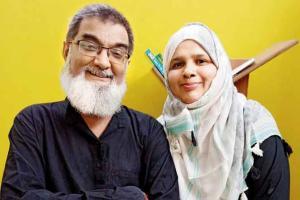Home / Sunday-mid-day / / Article /
Shaheen Bagh became a pilgrimage centre for secular India
Updated On: 19 July, 2020 08:03 AM IST | Mumbai | Jane Borges
A husband and wife who participated in a first-of-its-kind movement led by the Muslim women of Delhi, discuss how it became a metaphor for resistance

Ziya Us Salam and Uzma Ausaf
A FEW days into the stir at Delhi's Shaheen Bagh, which saw women from the Muslim community come out in droves to protest the controversial triad of National Population Register, National Register of Citizens and Citizenship Amendment Act, journalist-author Ziya Us Salam was invited to address them in the capacity of a journalist and an important voice of the community. This was in the last week of a freezing December, nearly seven days after the attack on students at Jamia Millia Islamia University, which had, in fact, bolstered these women to leave the confines of their homes to voice their protest. For some, it was perhaps, their first time in public eye. At the time, Salam had not thought much about the movement. "I went there with several preconceived notions. Like others, I didn't take them very seriously, and wondered if they'd know anything about nationalism or even the Constitution," he remembers. But a few hours at Shaheen Bagh were enough to alter those views. "It was a heart-warming experience. I came back chastened and enlightened." For the next few months, Salam and his wife Uzma Ausaf, a former journalist, would keep visiting Shaheen Bagh—a Muslim colony founded by one Ansarullah around 30 years ago, on tracts of agricultural land—to witness and live through this
new revolution.
Their new book, Shaheen Bagh: From a Protest to a Movement (Bloomsbury India) documents the journey of the making of Shaheen Bagh, and how within a matter of weeks, it spawned a hundred other mini movements across the country, including Mumbai. "As an Indian, as a Muslim and as a man, I was proud of what these women were doing," says Delhi-based Salam, who spent many mornings before work at the protest site. "For so long, the Indian media had portrayed Muslim women as helpless, vulnerable and fearful. This was far from the lived reality. So, when Shaheen Bagh happened, it surprised many people, including well-wishers who had imbibed that propaganda," he says, in a telephone interview. While the women countered this "propaganda" in the most efficient manner, what was most moving about the protest, says Salam, is that they didn't "come out to protest, as Muslims, but as Indian citizens". "They didn't bring a copy of the Quran or any fictitious green flag associated with the Muslims. They, instead, came with a tricolour flag in one hand, and the Constitution in the other. None of their demands were about the community. It was about the Right to Equality, given to them in Article 14 [of the Constitution]."




